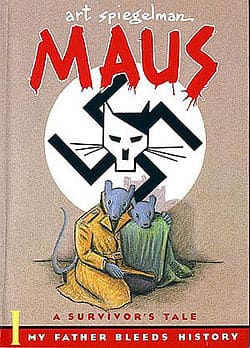Until Art Spiegelman arrived on the scene, comics had not truly been acknowledged as art. Never, until Art Spiegelman came along, had anyone won a Guggenheim Fellowship award in order to complete a work of cartoon art. In 1986, Art Spiegelman, hailed by some as the “new Kafka,” published Maus: A Survivors Tale, a graphic-novel depiction of his troubled relationship with his father, a Jewish survivor of Hitler’s Death Camps. Then, in 1991, he published Maus II: And Here My Troubles Began, which earned him a Pulitzer prize for both volumes.
Biography
Art Spiegelman was born on February 15, 1948, in Stockholm, Sweden, to Vladek and Anja (Zylberberg) Spiegelman.
Three years after his birth, his family immigrated to the United States, to the Rego Park area, in Queens, New York. His father, Vladek, was a wealthy textile salesperson and manufacturer in Poland. Before World War II, he worked in the garment trade and later in the diamond business.
Both of his parents survived confinement to the Jewish ghettos and imprisonment in the famous Nazi Concentration camp in Auschwitz, Poland.
His mother, Anja, suffered from periodic depression, and his father, perhaps acting on instincts that had once been necessary for survival, was obsessively frugal. His mother committed suicide in 1968 after barely surviving Auschwitz, and then coming to America.
Spiegelman was the youngest child to Vladek and Anja; he had a brother named Richieu. Richieu had been poisoned by an aunt who also killed two of Art’s cousins and herself just before the Nazis came to take them away.
Spiegelman began drawing as a child, spending time with a doodling game his mother had developed. She scribbled a little on a paper, and he would turn it into something. The game led to his drawing cartoons, and he began spending much of his time drawing. “At that point, I stopped wanting to be a fireman, policeman, or a cowboy–and opted for a cartoonist.”
One day when he was about ten, he asked his mother to buy him a book on how to draw cartoons. Because of her husband’s frugality, she made a deal with him: she would buy the book for him, if he could prove that he had benefited from it. If not, it would be deducted from his future allowance.
After that, Spiegelman began filling notebooks with his drawings and cartoons, copying styles from his favorite artists, like those who drew for MAD MAGAZINE, which he called a “terrific influence.”
Cartooning History
Despite his parent’s objection, Spiegelman intended to become a professional cartoonist. He wanted to go to High School of Art and Design, whereas his parents “wanted me to become a dentist.” “For them, dentist was halfway to doctor, I guess… They’d point out how if I become a dentist, I could always do drawing on the side, whereas if I became a cartoonist, I couldn’t very well pull people’s teeth during my off hours.
Their logic was impeccable, just irrelevant. I was hooked.” In the early 1960’s, he produced his own magazine, Blasé, an imitation of MAD. By the age of fourteen, he was selling cartoons and illustrations to the Long Island Post.
Today, Spiegelman and his wife Francoise Mouly make Raw (“The ‘graphix’ magazine that overestimates the taste of the American public”) in which Spiegelman first introduced Maus, and to which he and other artists contribute work. It is basically a magazine devoted to new and unusual work in the graphic story medium.
For example, one of the most famous “practitioners of the underground,” Robert Crumb, has provided cover art, and more. Raw was preceded by a magazine, also published by Spiegelman, called Arcade, a magazine started in the mid-1970s for people involved in underground comics. Then when Spiegelman met Mouly, they started Raw together.
Comics as Art
For the past thirty years, the development of the typical American comic, a Superman and Batman type of comic, has been very different from that of its Japanese and European equivalent.
Whereas American educators for many years considered comics as children’s entertainment of dubious literary value, European and Japanese comics soon developed a more adult and more serious content. For that reason, people become offended when others refer to these more serious works as “comics.”
Spiegelman became one of the first major artists of “adult” comics since the first graphic novel-comic called “Barefoot Gen” was written about Hiroshima and the atomic bomb. Spiegelman, who felt that Barefoot Gen was one of the most memorable works he had ever read, won America’s premier award for literature for Maus I & II, the Pulitzer Prize, in 1992.
Maus
Having learned in a film class in college that in early animated cartoons, rodent characters often represented black people, he thought of using mice to tell a story of blacks in America. As he explained in an interview, “That idea lasted for about forty-five minutes.
Because what did I know about blacks in America? And then suddenly the idea of Jews as mice just hit me full force, full-blown. Almost as soon as it hit me, I began to recognize the obvious historical antecedents–how Nazis had spoken of Jews as ‘vermin,’ for example, and plotted their ‘extermination.’
” Inspired by that, he began his work with a three-page cartoon which he gave to his father about the Holocaust that ends with mice being taken to a concentration camp called “Mauschwitz.”
Then, in about 1978, Spiegelman felt that he had come to a turning point in his cartooning work, and he decided to further develop his three-page comic strip, Maus. He turned the three-page comic strip into a 295-page book which ultimately consumed 13 years of work. For his research, Spiegelman had moved back to New York City, where he talked at length with his father about his Holocaust experiences.
Styles in Maus
Although the style of the finished book is deceptively simple, a delayed process was required to complete each page. Starting with his father’s taped memories, Spiegelman condensed remarkable scenes and scraps of dialogue, which in turn were refined to fit a comic strip’s relatively restricted framework.
The artist deliberately adopted an austere, pared-down style in order to make his mouse and cat metaphor as clear as possible and to create a seamless flow between word and image.
Spiegelman uses a “comic-book” medium to convey a story of the Holocaust, and he succeeded in completely changing the way stories of the Holocaust were told.
It also changed the way comic books have traditionally been used. It changed the way the comics had always been presented, and this change represents a historical milestone from the way that they had always been used as super-hero construction and morality plays.
He reduces the people to cats, mice, and pigs (Nazis, Jews, and the Poles), in order to offer conscious, intentional miniaturization and reduction, pointing up not merely the way the Jews were treated during the Holocaust, but also represents the present-day response to the Holocaust.
Throughout the book, there are also dialogue boxes, images, commentary, as well as maps of Poland and the camps, diagrams of hideouts, real photographs from his family archive, detailed plans of the crematoria, and exchange table for goods at Auschwitz, and even a manual for shoe-repair.



very helpfull
very helpful
I needed this site. It has been the only useful site I could find on Art Spiegelman.
This has been one of the most helpful sites I’ve visited as a college student.